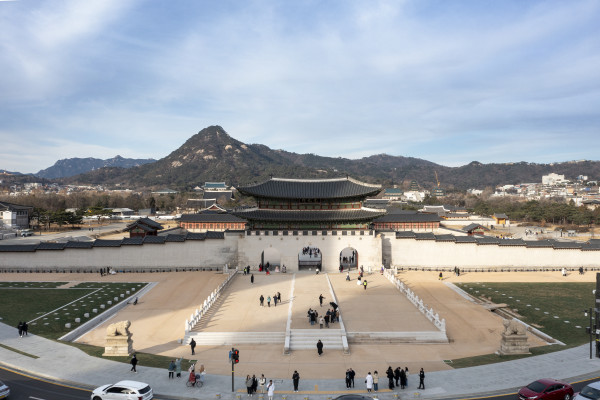Gyeongbokgung
-
Name GyeongbokgungAddr 161, Sajik-ro, Jongno-gu, Seoul
-
Tel 02-3700-3900Dist 11km
- Transp Go to Yeongdeungpo Market Station (on foot), take subway line 5 (9 stations in the Gwanghwamun direction), get off at Gwanghwamun Station (exit 2), and walk.
- URL
본문

Gyeongbokgung Palace was built by King Taejo in 1395 as the legal palace of the new Joseon Dynasty, and boasts the greatest scale and architectural beauty among the five major palaces.
The kings who held coronation ceremonies at Geunjeongjeon in Gyeongbokgung Palace include the 2nd King Jeongjong, the 4th King Sejong, the 6th King Danjong, the 7th King Sejo, the 9th King Seongjong, the 11th King Jungjong, and the 13th King Myeongjong.
During the Japanese invasions of Korea, many of the buildings were burned down, and during the reign of King Gojong, under the leadership of Heungseon Daewongun, over 7,700 buildings were rebuilt. However, with the assassination of Empress Myeongseong again, the dynasty fell and Gyeongbokgung Palace lost its function as a royal palace.
In Gyeongbokgung Palace, the representative buildings of the Joseon Dynasty, Gyeonghoeru and the pond of Hyangwonjeong, remain in their original form, and the statues of Geunjeongjeon represent the sculptural art of the time. Currently, the National Palace Museum is located on the west side outside Heungnyemun Gate, and the National Folk Museum is located on the east side of Hyangwonjeong Pavilion in Gyeongbokgung Palace.
Major cultural properties : Historic site Gyeongbokgung Palace, national treasure Gyeongbokgung Palace Geunjeongjeon, national treasure Gyeonghoeru Gyeongbokgung Palace, treasure Gyeongbokgung Palace Jagyeongjeon, treasure Gyeongbokgung Palace Jagyeongjeon Chimney of the Ten Longevity Life, treasure Gyeongbokgung Palace Amisan Chimney, treasure Gyeongbokgung Palace Geunjeongmun and Haenggak, treasure Gyeongbokgung Punggidae
The kings who held coronation ceremonies at Geunjeongjeon in Gyeongbokgung Palace include the 2nd King Jeongjong, the 4th King Sejong, the 6th King Danjong, the 7th King Sejo, the 9th King Seongjong, the 11th King Jungjong, and the 13th King Myeongjong.
During the Japanese invasions of Korea, many of the buildings were burned down, and during the reign of King Gojong, under the leadership of Heungseon Daewongun, over 7,700 buildings were rebuilt. However, with the assassination of Empress Myeongseong again, the dynasty fell and Gyeongbokgung Palace lost its function as a royal palace.
In Gyeongbokgung Palace, the representative buildings of the Joseon Dynasty, Gyeonghoeru and the pond of Hyangwonjeong, remain in their original form, and the statues of Geunjeongjeon represent the sculptural art of the time. Currently, the National Palace Museum is located on the west side outside Heungnyemun Gate, and the National Folk Museum is located on the east side of Hyangwonjeong Pavilion in Gyeongbokgung Palace.
Major cultural properties : Historic site Gyeongbokgung Palace, national treasure Gyeongbokgung Palace Geunjeongjeon, national treasure Gyeonghoeru Gyeongbokgung Palace, treasure Gyeongbokgung Palace Jagyeongjeon, treasure Gyeongbokgung Palace Jagyeongjeon Chimney of the Ten Longevity Life, treasure Gyeongbokgung Palace Amisan Chimney, treasure Gyeongbokgung Palace Geunjeongmun and Haenggak, treasure Gyeongbokgung Punggidae
- Prev PostChanggyeonggung Palace